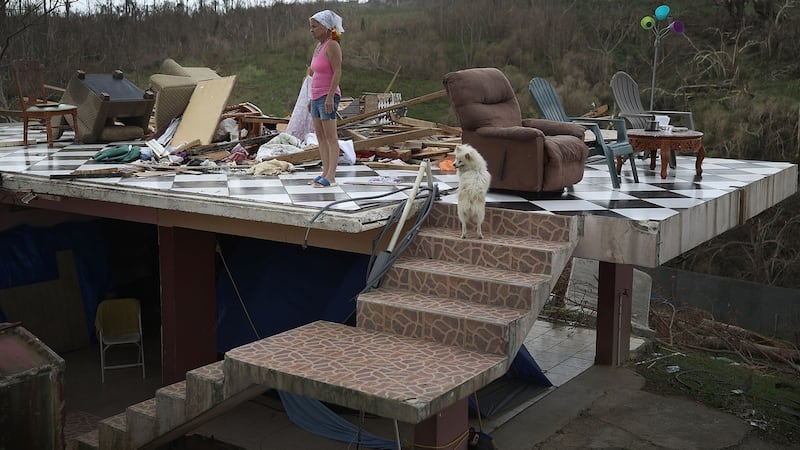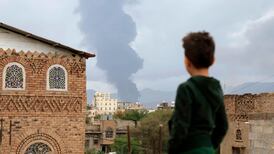Last October, US president Donald Trump visited Puerto Rico for a photo op, 13 days after Hurricane Maria had ripped across the island, leaving its residents, communities, roadways and power grid in tatters.
“I’ve been to Puerto Rico many times as, I think, most of you have known. And I’ve always loved it. And your weather is second to none, but every once in a while you get hit. And you really got hit,” Trump told the crowds greeting him.
“Every death is a horror. But if you look at a real catastrophe like Katrina, and you look at the tremendous hundreds and hundreds and hundreds of people that died, and you look at what happened here with, really, a storm that was just totally overpowering, nobody has ever seen anything like this. What is your death count, as of this moment – 17?”

Someone at the gathering told the president the figure was slightly lower: 16. “16 people certified. 16 people versus in the thousands,” Trump said. “You can be very proud of all of your people, all of our people working together. 16 versus literally thousands of people. You can be very proud. Everybody around this table and everybody watching can really be very proud.”
Trump emphasised all that the federal government had done to assist Puerto Rico when he wrapped up his speech.
“I appreciate your support and I know you appreciate our support, because our country has really gone all out to help. And it’s not only dangerous, it’s expensive, it’s everything,” he said. “But I consider it a great honour, maybe because I know so many people from Puerto Rico that are such great people. I come from New York.”
Death toll
On Tuesday the New England Journal of Medicine published a new estimate of the lives lost on Puerto Rico due to Hurricane Maria: about 4,600. That stands in stark contrast to the 16 deaths the president cited in October, and the official death toll of 64 that the Puerto Rican government has stood by for months.
To put the tragedy in context, consider the death tolls from other recent hurricanes.
Hurricane Camille, one of the most brutal hurricanes to hit the US in the late 20th century, made landfall in Mississippi in 1969 and left about 260 dead. Hurricane Andrew killed about 65 people when it swept across the Bahamas and Florida in 1992. Hurricane Irma left about 130 dead last year; Hurricane Harvey, a companion of sorts to Irma, killed about 110.
Hurricane Katrina, which Trump cited as benchmark of catastrophe, left about 1,800 dead after it made landfall in Florida, Louisiana and Mississippi in 2013. Some 3,000 people died in the terrorist attacks on the World Trade Centre in September, 2001.
Compared to all of these events, Hurricane Maria represents an epic loss of life. And the New England Journal noted that its estimate of about 4,600 dead on Puerto Rico "is likely to be an underestimate". It said that the "mortality rate remained high through the end of December 2017, and one third of the deaths were attributed to delayed or interrupted health care".
Reporters on the ground in Puerto Rico last autumn saw this coming. As they toured the island after Maria hit, it was obvious that Puerto Rico’s heavily damaged hospital system and unreliable power grid would conspire to produce deaths well in excess of the government’s (and Trump’s) lowball figure of 16.
"It's unclear what is happening with the deceased who are at the morgues of the 51 hospitals that have had to close their doors," the Miami Herald wondered last fall. BuzzFeed News provided an answer about what was happening to some of the corpses that were piling up at the time: They were being burned.
When I visited Puerto Rico in November, I noted that it was “swamped in a humanitarian crisis, with running water still unavailable in some areas, roadways in disrepair, thousands of people living in shelters and about 100,000 people estimated to have fled since the hurricane hit on September 20th”.
A perfect ‘10’
Puerto Rico’s challenges were perfectly suited to a veteran builder and a self-described man of action like Trump, yet he seemed uninspired by – and unengaged with – the task at hand.
A reminder of the timeline surrounding Trump's response to Hurricane Maria is instructive. Two days after the storm made landfall on Puerto Rico, Trump was campaigning in Alabama and said nothing about it. His first tweets about Maria weren't posted until September 25th. His first situation room meeting in the White House to discuss how to respond to the catastrophe occurred a day later.
To be sure, Puerto Rico presented unique challenges. It is mountainous, surrounded by water, and plagued by corruption and political mismanagement. Yet some of these problems faced the Obama administration when it responded in 2010 to an earthquake in Haiti. There, the US deployed 8,000 troops in a couple of days. Two weeks later, 22,000 troops had been dispatched. The Trump administration had only 7,200 members of the military in Puerto Rico two weeks after Hurricane Maria touched down.
Trump, undaunted, gave himself a “10” when asked by White House reporters to grade the federal response to Hurricane Maria about a month after it first ravaged Puerto Rico. That perfect self-assessment came at a time when electricity and potable water were still in short supply on the island.
Puerto Rico’s residents remain saddled today with an unreliable power grid, despite billions of spending and public-private partnerships overseen by the US government and the Trump administration that were meant to address the problem.
More than infrastructure is also at stake in Puerto Rico, of course. Lives have been lost; about 4,600 of them, and counting. With the next hurricane season just around the corner, Trump has a brief window to try to secure Puerto Rico’s future – and actually earn his 10. – Bloomberg









